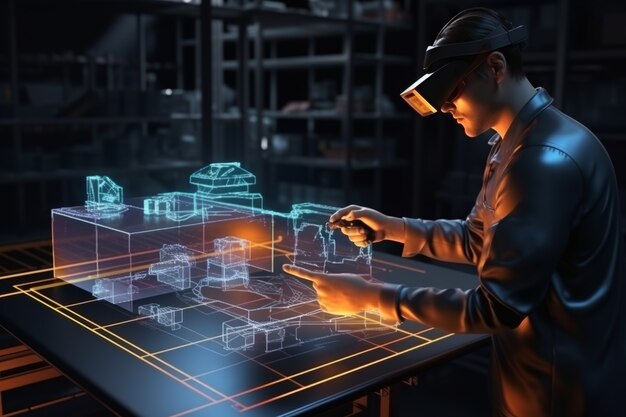The construction industry, like many others, has gone through an amazing transformation over the last few decades. Innovations in generation have reshaped how buildings are designed, built, and controlled. With the growing call for faster, more efficient, and sustainable solutions, era is playing a pivotal function in revolutionizing the construction zone. From advanced challenge control equipment to modern substances, here’s how technology is using exchange and enhancing each aspect of construction.
Building Information Modeling (BIM) | Enhancing Precision and Collaboration
One of the most widespread improvements in the creation of technology is the sizeable adoption of Building Information Modeling (BIM). BIM is a digital illustration of an introduction challenge that provides architects, engineers, contractors, or maybe FF&E Procurement Company with a shared platform to collaborate. The era allows the appearance of three-D models that visualize every element of production, collectively with structural, mechanical, and electric structures.
The primary advantage of BIM is its ability to enhance collaboration among stakeholders. Rather than counting on static 2D blueprints or paper-primarily based plans, BIM allows for actual-time updates and adjustments. This streamlines decision-making and minimizes errors, as all events have get right of entry to the same records. BIM additionally helps better resource allocation and scheduling, ultimately decreasing fees and delays. With BIM, creation projects are greater efficient, and the first-rate of the very last product is drastically stepped forward.
Drones | Providing Aerial Insights and Site Monitoring
Drones have quickly grown to be an essential device for construction site monitoring and inspections. Equipped with excessive-definition cameras and sensors, drones offer actual aerial pictures, giving assignment managers an unparalleled view of construction progress. This generation is specifically useful for surveying massive websites, which would traditionally take days to map out manually.
Beyond surveying, drones are used to reveal job websites for protection, ensuring that people are following protocols and that equipment is being used well. They also allow for particular measurements and may seize difficult-to-attain areas without the need for scaffolding or ladders. By the use of drones for habitual website inspections, construction businesses can keep each time and money, lowering the need for guide labor even as enhancing common website online protection.
3-D Printing | Redefining Construction Materials and Processes
While still in its early degrees, 3-D printing is about to revolutionize production by means of allowing the advent of custom constructing additives on demand. 3D printers use virtual files to layer substances—together with concrete, plastics, and metals—into unique shapes, doing away with plenty of the waste associated with traditional construction strategies.
One of the maximum thrilling possibilities of three-D printing is the ability to print complete systems, together with houses and bridges. This can significantly decrease creation fees and decrease cloth waste, aligning with the growing call for sustainable construction practices. Three-D-printed homes, for instance, offer a greater less expensive housing solution, specifically in regions dealing with shortages. In addition, 3D printing allows for greater difficult designs that would be tough, if no longer impossible, to reap with conventional techniques.
Artificial Intelligence (AI) and System Mastering | Streamlining Project Management
Artificial intelligence (AI) and system mastering are transforming how creation tasks are managed. By reading giant amounts of information from beyond tasks, AI can assist expect capacity risks and delays, permitting task managers to deal with issues earlier than they arise. AI-powered software can examine developments, pick out patterns, and offer insights that might be hard for people to uncover.
For instance, AI can help in undertaking scheduling by way of reading contemporary workloads and determining the maximum green use of assets. It can also assist with budgeting, ensuring that prices continue to be inside the task’s monetary constraints. Furthermore, AI can automate habitual obligations, including invoicing and progress monitoring, releasing assignment managers to the cognizance of greater strategic obligations.
Robotics and Automation | Enhancing Efficiency and Reducing Labor Shortages
The upward thrust of robotics and automation is another sport-changer for the construction industry. The Robotics era is now getting used for responsibilities inclusive of bricklaying, demolition, and even welding. By automating those repetitive and bodily demanding jobs, construction organizations can boost productiveness even by decreasing the danger of human errors and injury.
Automation also addresses one of the maximum pressing challenges in construction: hard work shortages. Many professional labor jobs have become increasingly harder to fill, and automation can assist bridge that gap. With robots managing certain obligations, production organizations can lessen their reliance on guide exertions and make certain tasks stay on track regardless of staff shortages.
Augmented Reality (AR) and Virtual Reality (VR) | Visualizing Projects Before Groundbreaking
Augmented Reality (AR) and Virtual Reality (VR) are two technologies that have been confirmed to be valuable inside the layout and production stages. AR permits production teams to overlay virtual fashions onto physical spaces, supplying a clear visualization of what a completed project will seem like. VR, then again, gives immersive environments wherein clients, contractors, and designers can explore a virtual representation of the challenge before production starts.
This technology not only enhances the design process but also helps with schooling and safety simulations. For instance, workers can use VR to exercise competencies and enjoy capacity dangers in a managed environment, enhancing safety at the process website. Additionally, AR and VR help beautify communication among designers and clients, permitting them to make informed selections and adjustments early in the process, lowering high-priced adjustments down the line.
Internet of Things (IoT) | Smart Monitoring and Data Collection on Sites
The Internet of Things (IoT) has observed its place in production via the mixing of smart devices and sensors. These devices are embedded in construction gadgets, materials, and systems to acquire facts in actual time. These statistics are then used to display the whole lot from the structural integrity of a construction to the circumstance of machinery.
For instance, IoT sensors can discover changes in temperature, humidity, or pressure on materials, providing early warnings if something goes wrong. This proactive approach can assist prevent luxurious repairs and downtime. IoT also plays a key function in improving creation website protection, as sensors can tune employee actions and equipment usage, making sure that safety protocols are followed.
Sustainable Construction Technologies | Reducing Environmental Impact
With growing worries about climate alternatives, sustainable construction technology is gaining traction. Innovations along with power-efficient buildings, green substances, and occasional-carbon production strategies are supporting the enterprise reduce its environmental footprint.
One such era is carbon-taking pictures concrete, which absorbs CO2 from the ecosystem in the course of the curing method, supporting offset emissions. Additionally, sun-powered equipment and inexperienced constructing designs that prioritize herbal lighting and ventilation contribute to decreasing strength consumption. The use of Quality Galvanized Steel Coil in creation also performs a key role in enhancing sturdiness and sustainability. These sustainable answers no longer only benefit the surroundings but also help creation groups meet stringent construction codes and appeal to environmentally aware customers.
Conclusion
Technology is undeniably changing the face of construction. From streamlining strategies and decreasing fees to improving protection and sustainability, the impact is profound. As the construction enterprise continues to embody those improvements, the future appears brighter than ever. Companies that live ahead of technological traits might be better equipped to satisfy the evolving demands of the market, while also contributing to a more sustainable and efficient future for the constructed environment.
By adopting technology like BIM, drones, 3D printing, and AI, creation corporations can stay aggressive, enhance the high quality of their projects, and better serve their customers. The position of an era in revolutionizing construction is plain, and its persistent integration will form the industry for years to come.







